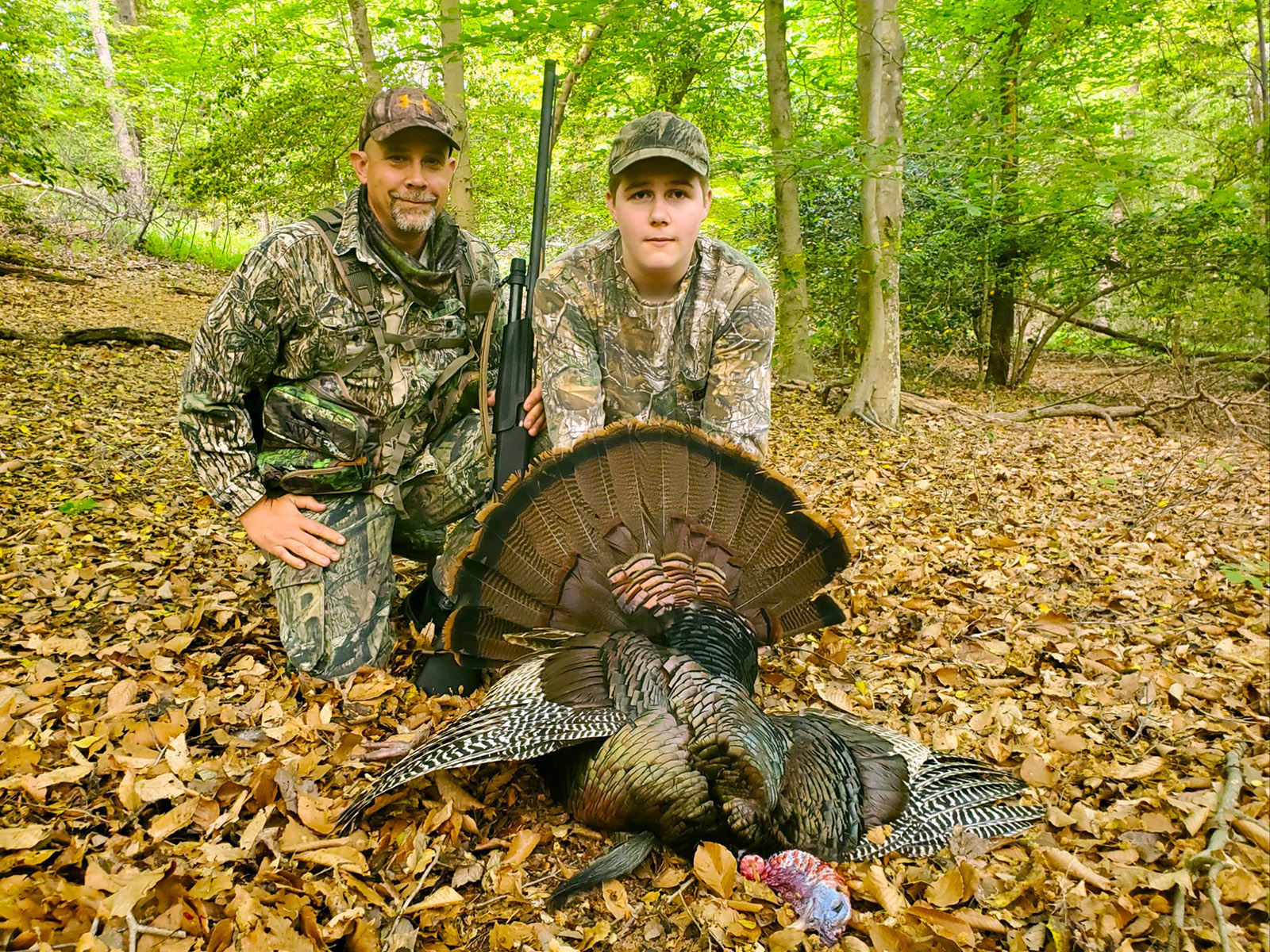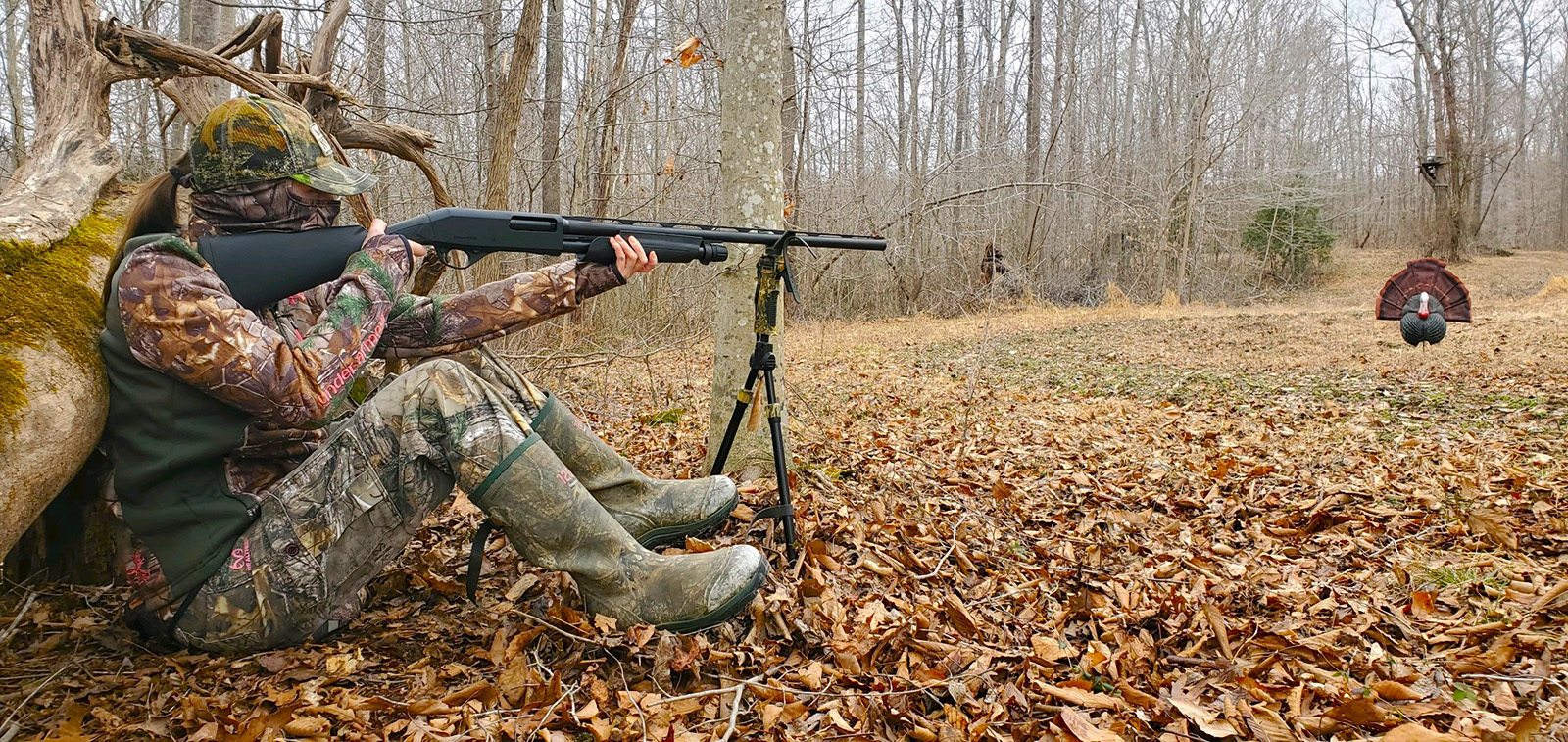By Mark Fike
Photos by Mark Fike
Spring gobbler hunting is incredibly addictive as so many already know. However, starting a new hunter off improperly may turn them off from such a fun method of hunting. Here are some tips to keep in mind when introducing your new hunter to our pastime. Youth and Apprentice Spring Turkey Weekend is April 6-7 this year—make a plan to share the fun of a day afield!

Lt. Frank Spuchesi (left) with a young hunter and his first harvested wild turkey. Sharing the skills to make for a successful day in the spring turkey woods is rewarding.
Use a Blind
We all make mistakes, and it is important that we remember that when our new hunter takes the field with us. Try to teach your protégé the ins and outs before heading afield, but know that something will be forgotten by those of us teaching or our hunter.
To keep these mistakes from being costly, plan ahead and consider using a blind. Use of a blind allows for some movement, and turkeys seem to not be bothered by a new blind on a landscape unlike many deer that tend to shy away from such things.
- Some tips for using blinds include the following:
- Get a blind that is simple to use, even in the dark when you may have to set it up.
- If possible, set it up prior to the hunt to make the morning hunt that much easier.
- Look for a blind that is large enough to comfortably house you and your new hunter with turkey vests and stools too.
- When using the blind, keep windows you do not absolutely need closed. This is particularly important for windows behind you, as movement is much easier to see if you are “sky lined” by an open window behind you.
Scouting
I prefer to have several properties lined up to hunt, if possible, just in case the birds are not vocal at one location. Take your hunter with you to scout and listen for birds before the hunt or at night to “roost” a bird. That will help you have choices, but it can also amp up the excitement level in the new hunter and offer time for some question and answers sessions when you can mentor your hunter even more. If you both hear a bird on the property, it is less boring when you go hunting knowing there is a bird there, but it may not gobbling for the time being.
Outfitting
If you want to help your new hunter feel like a hunter, help get them outfitted. If they have the means, accompany them to the store to get the basics. However, if you can loan or give them items, then do so. Feeling the part is important for new hunters. You do not have to outfit them with everything, but do set them up with the basics.
Shooting Practice
Before I take a hunter spring gobbler hunting, we have a discussion about gun safety and hunting safely. I encourage taking the hunter education course, but apprentice hunters can buy the apprentice license first. Regardless, take them shooting. Make sure the shotgun they are going to use is a good fit and they can properly shoulder it from a seated position with the hunting clothing on to include a mask. Put out a paper target such as a can at 25 or 30 yards and have them shoot it with some bird shot. You do not have to use the turkey loads at first. Have them get comfortable shooting cans from various hunting positions in the blind or mimicking the blind or sitting up against a tree. This builds confidence in them and you.
Once you have accomplished this task, if you need to pattern the shotgun with the turkey loads, do so, but have them shoot once they get some practice with less expensive loads first. Be sure to use loads that are effective. Don’t skimp and risk wounding the bird.
When shooting, explain what the effective range of the shotgun is on a turkey and explain where to aim on a turkey (neck/head). Discourage risky or longer-range shots. Be patient and model that for them when hunting so they can learn properly.
When I set out decoys, I try to explain to my new hunters how much past the decoy they can shoot if need be. Often, I will place a stick in a visible spot prior to hunting where the max range is. Be the hunt master and you call the shot, though. It is best to be in charge and not allow them to shoot until you know the bird is in range. The actual shot at that point will be done when the new hunter is sure they can make it.

Practicing with a decoy can be valuable for a new hunter.
Calls
Some mentors prefer to do all the calling for new hunters. There is a good reason for this—often the veteran hunter knows the right combination of calling and the frequency of calling to do for a successful harvest of a spring gobbler and all of us mentors want to see our hunters smiling big in a photo with their first gobbler.
However, there is something to be said about new hunters getting to call too. I tend to have practice sessions with my hunters with box and slate calls or friction calls prior to the hunt. We may even practice on the way to the hunting property. I go over the basics with them and encourage them to call infrequently and only when I suggest it. I want them to call and be a part of their first bird experience beyond pulling the trigger, but you don’t want them to call so much they turn a box call into sawdust either!
Sometimes, we tag team calling. I might cluck a little and then, using my eyes, suggest they mimic what I did. We both have calls that sound different, which ends up sounding like two different hens. This is not only exciting for the potential gobbler to know he has choices, but also the new hunter is now part of the game too.
Last, if you have time, consider helping your new hunter make their own call. Lt. Frank Spuchesi, of the Virginia Department of Wildlife Resources Conservation Police and I offer a call-making event for youth at our local school each spring. The kids assemble box calls and friction calls, learn how a friction call works, and enjoy the simplicity of a box call. We encourage them to customize the calls with paint and wood-burning to make them their own.

Learning to assemble a turkey call can get young people engaged with hunting.
Any age new hunter can do this, and it is a lot of fun. One of our guest speakers, Monty Clift, who is an avid turkey hunter, even showed the kids his turkey wing bone call he made. He challenged the kids to harvest their first bird with the calls they made with Lt. Spuchesi and I, and he offered to take their wing bone from their turkey and make them a call from it. One youth took him up on it and he delivered! That youth hopes to take his second turkey using the wing bone call this season.
This season, mentor a new hunter. Use the tips above to make it fun and enjoyable, and know you did your part to pass our tradition on to others. Don’t forget the insect repellent and check for ticks!


